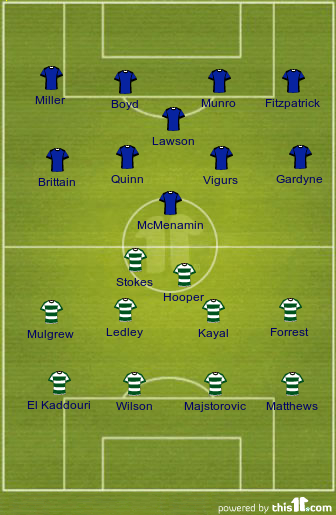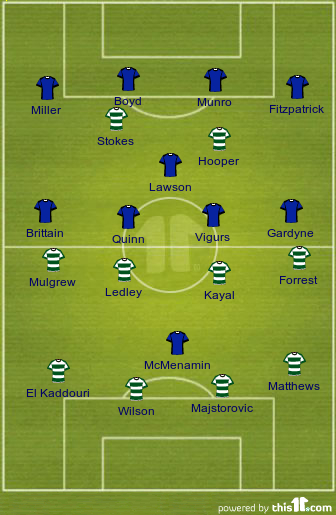This article is written as a supplement to the most excellent TicTacTic’s analysis already published.
Apologies in advance for the lack of Celtic colours in the Subbuteo kits.
As usual, the annotations on the pictures are as follows: defenders = green; midfielders = yellow; attacking midfield = orange; forwards = red. Please click on the Subbuteo illustrations for further annotation.
INTRO
Celtic eventually won this game quite comfortably, controlling the match for large enough periods.
However, the first half was quite competitive and statistically there might not have been much between the two sides. Even if Celtic enjoyed most of the possesion, County controlled the space on the pitch and were unfortunate to go behind in the match, with Hooper taking advantage of a goalkeeping error at a corner. For most of the first half, County’s quick tempo threatened to exploit Celtic’s fragile looking defence, but the breakthrough never happened.
Ultimately, County’s agressive defensive line receded and Celtic scored early in the second half with an own goal from Scott Boyd. Celtic looked more balanced from the second half due to a tweak to their system. County struggled to get into the game from then on.
FORMATIONS


How the two teams lined up against how the formations matched up.
Celtic played a fairly traditional 4-4-2 system, with Gary Hooper dropping off behind Anthony Stokes to link with his midfield. Mulgrew started on the left of midfield and would normally have tucked in a little to compensate for Forrest retaining a high, wide right position. However, Mulgrew was instructed to make the most of a deceptively wide pitch at Victoria Park. This was in order to stretch County’s defence as much as possible and make some space in a congested midfield.
Ross County played a 4-1-4-1 formation, last seen in the first half of the recent away match to Falkirk. Lawson sat behind the main midfield four, with County leaving McMenamin with a lot to do on his own up front.
McMenamin’s biggest help up front came from Brittain and Gardyne getting forward to help. Rocco Quinn got forward from central midfield to play behind McMenamin. Iain Vigurs, as the other central midfielder, played somewhere in between where Lawson and Quinn played. Vigurs was in essence the creative outlet of the team. County’s formation, when high up the pitch in Celtic’s half, more closely resembled a 4-2-1-3 formation, with Vigurs in the band of ‘2’ but more of a creative pivot than Lawson beside him.
CELTIC POSSESSION
The first thing to note on Celtic’s approach to the match was how disciplined the team were in keeping the ball on the grass, rather than in the air. It might be natural to expect a SPL team to control more possession of the ball than a SFL side, but the style was a surprise. Celtic tried to play a slick passing game on wet surface, with very few long balls attempted.
Joe Ledley linked well with defence to help play out of danger. Celtic used passing triangles out of defence and through midfield in a fashion not often seen in Dingwall by opposing teams. Even if County’s high line prevented any real danger from Celtic’s possession, it was still an attractive style to see from a Scottish team. Typically, Celtic might have normally relied on the odd direct ball to mix their play up, but the treacherous weather conditions were enough to discourage the higher-risk direct approach for them.
Most of the Celtic team were comfortable in holding the ball, but the defence was not great in possession. Kelvin Wilson often hesitated under pressure from McMenamin, as did El Kaddouri under pressure from Brittain at left-back.
While Celtic wanted to control the match with their own relatively safe possession, County’s strategy was to get McMenamin running at and beyond the Celtic rearguard as often as possible, with long balls coming from defence and deep midfield. With McMenamin as the lone forward, County had to use a higher-risk (in terms of losing possession) strategy than Celtic, in the hope that one of their early long passes would drop kindly for McMenamin behind Majstorovic and Wilson.
County’s high line meant Celtic could pass to just inside County’s half, but Celtic found it difficult to get behind County’s defence. Charlie Mulgrew therefore hugged the touch-line on the left and as the first half progressed, El Kaddouri showed more courage in supporting Mulgrew. Gary Miller would often tuck in beside his centre-backs, so Brittain could be over-loaded and Mulgrew’s delivery was a danger to County at times (see the first Subbuteo pic above).
VAGARIES OF LAWSON’S INFLUENCE
Before moving on with some more analysis, it is worth discussing Paul Lawson’s role in the match. He missed most of the victory at Hampden against his former club and would have been keen to impress.
Lawson had a key role supporting the defence and midfield, but it wasn’t his best game for a number of reasons:
- He ought to have been a passing outlet for the defence, but with Hooper dropping deep and Stokes pulling wide left at times, Lawson didn’t always find the appropriate angle to make himself available for the short pass.
- He ought to have been an easy option for midfielders to keep possession in the middle of the park, but was curtailed in this respect by 1) Hooper dropping deeper and blocking Lawson’s space, and 2) County’s very high line compressing the midfield area.
- In theory, this might have not been that detrimental to County’s performance, as County’s defence and central midfield often released early balls to McMenamin, to trouble the Celtic defence. In practice, Lawson’s ability to dictate the pace of County’s attack was notable in its partial absence.
- That is not to say Lawson had a terrible match, and still carried out his role as best as he could in the circumstaces, but as the designated ‘spare man’ at the back of midfield, he would have liked to have enjoyed more of the ball than he got.
COUNTY’S FAILURES
Here are some more comments on where it went wrong for County in the match.
Brittain failed to put in dangerous crosses from open play. He always had to cut on to his left foot from the wide-right position, as he didn’t have the pace, nor the trickery to beat El Kaddouri in the right-wing/left-back position. A number of County’s moves – particularly in the first half – would get to Brittain in this position, but Majstorovic and Wilson would gladly head away any crosses floated in front of them.
As County generally looked their most impressive when playing such a high defensive line, they looked their most vulnerable when the defence was deep. The two goals that Celtic scored came from the County defence defending on or in their six yardbox.
It is stating the obvious that McMenamin was often left with too much to do on his own up front.
Gardyne started at left-wing, which is a relatively un-natural position for him. He looks dangerous there when he has an over-lapping left-back, but Fitzpatrick simply wasn’t willing to get forward much when he had the threat of Forrest behind him.
CELTIC’S COMFORT
- In the second half, Charlie Mulgrew went to centre-back in place of the substituted Wilson. Mulgrew was notably more composed than Wilson on the ball and Mulgrew became a key figure in starting Celtic’s attacks.
- With Celtic able to pass out of defence with more confidence, Kayal’s influence in the game rose.
- Forrest found a lot of space behind Gardyne – and for some time Vigurs – in Celtic’s right-wing position.
- Celtic tried to release Forrest as quickly as possible, which was one of the contributing factors towards County’s deeper defensive line, compared to the first half.
- Joe Ledley was moved to left-midfield, where Mulgrew played in the first half. Ledley didn’t get forward to the same extent as Mugrew, but he brought balance and steel to the midfield to compensate for Forrest on the right attacking so intently.
With Forrest so high at times, and Hooper dropping deeper to link the midfield with attack, the attacking shape often looked like a triangle with Forrest almost as an auxiliary striker.
CONCLUSION
Ross County used what might have been the correct strategy on another day, but paid the price of not being able to 1) make the most of Celtic’s nervous defence in the first half when they pressed at a high tempo, and 2) getting caught defending too deep at times. County needed to ensure they took advantage of any chance in front of goal that was afforded to them, given the difference in ability between the two sides, but it wasn’t to be.
Celtic sometimes looked fragile in defence in the first half, but a half-time change brought more balance to the back line and the team pretty much looked comfortable from then on.






Pingback: Ross County 1 – 1 Celtic 18/08/12 | rosscountytactics.com